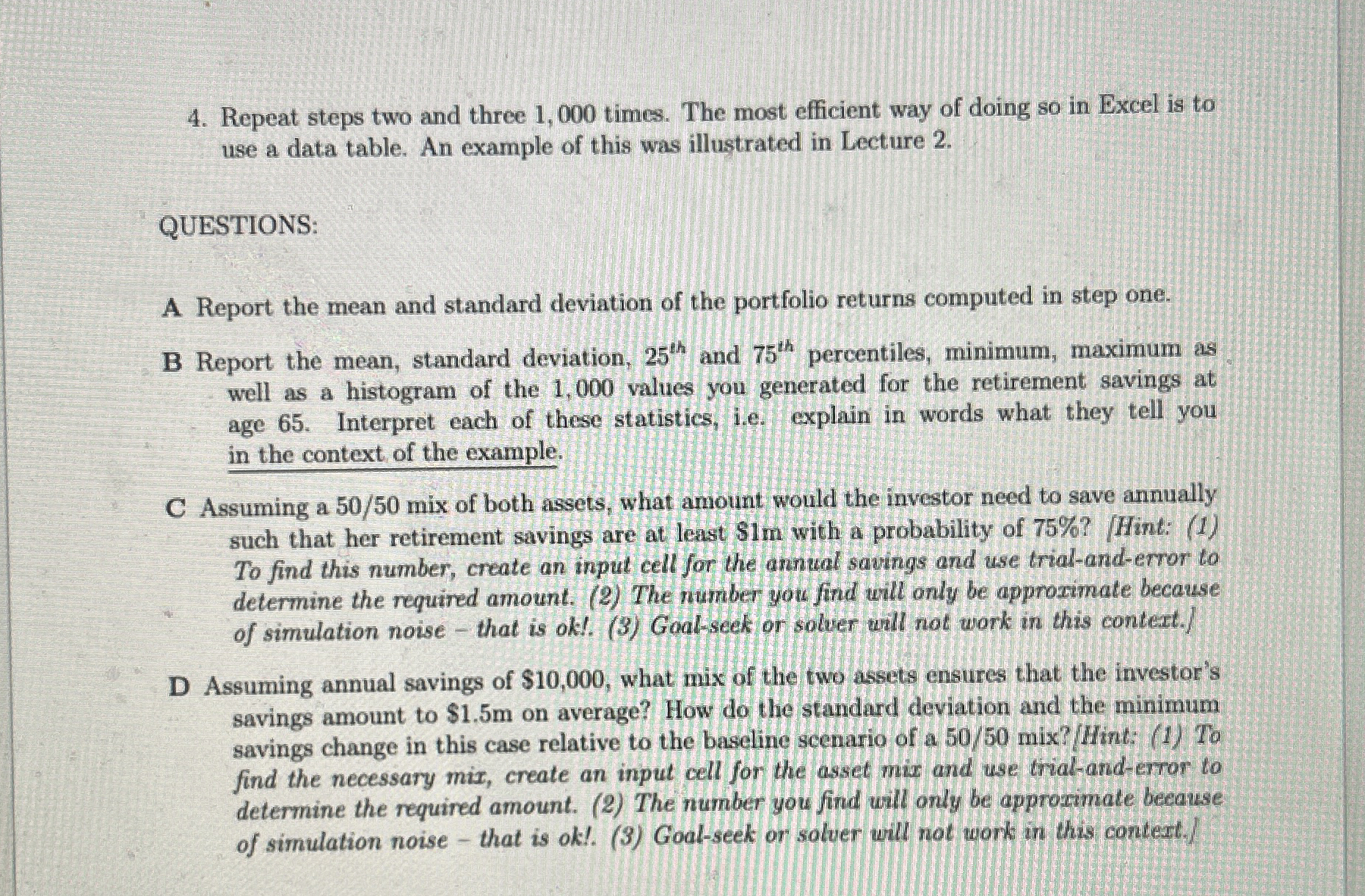Answered step by step
Verified Expert Solution
Question
1 Approved Answer
Saving for Retirement Assume an investor begins saving for retirement at age 2 5 and retires at age 6 5 . Each year, she contributes
Saving for Retirement
Assume an investor begins saving for retirement at age and retires at age Each year, she
contributes $ to her retirement account. To keep things simple, assume that there are
annual contributions that occur on the investor's dotsth birthdays, and that the
final retirement wealth is determined on the investor's th birthday. Savings are invested as
follows: in a broad stock market index and in TBills.
Your task is to compute the accumulated real retirement savings at age for different return
realizations. As explained below, you will generate returns using a Monte Carlo simulation. On
Canvas, you can find an Excel file containing historical net returns on the S&P and month
Tbills, as well as the consumer price index CPI from to The return on the CPI
serves as a measure of inflation.
STEPS:
Compute the annual real return on the portfolio for each year in the sample. The
resulting set of portfolio returns represents the empirical distribution. These are the
returns investors historically realized when investing in a mix of stocks and Tbills
over this time period.
We will use the historical data to assess what may happen in the future via a Monte Carlo
simulation. To generate a possible path of future returns, draw times with replacement
from the empirical distribution. Assuming the historical returns are located in the
cell range H:H a random draw can be generated with
INDEx: RANDBETWEEN
The set of draws you generated can be viewed as one scenario of what may happen in
the next years.
Ising the simulated return nath, compute the investor's wealth at age
Assume that no additional contribution is made on the th birthday.
Recall that this procedure is valid under the assumption that returns are independently and identically
distributed iid In other words, we assume that each of the return realizations computed in step one represents
an equally likely draw from the same distribution of possible returns.
Repeat steps two and three times. The most efficient way of doing so in Excel is to
use a data table. An example of this was illustrated in Lecture
QUESTIONS:
A Report the mean and standard deviation of the portfolio returns computed in step one.
B Report the mean, standard deviation, and percentiles, minimum, maximum as
well as a histogram of the values you generated for the retirement savings at
age Interpret each of these statistics, ie explain in words what they tell you
in the context of the example.
C Assuming a mix of both assets, what amount would the investor need to save annually
such that her retirement savings are at least $ with a probability of Hint:
To find this number, create an input cell for the annual savings and use trialanderror to
determine the required amount. The number you find will only be approximate because
of simulation noise that is ok Goalseek or solver will not work in this context.
D Assuming annual savings of $ what mix of the two assets ensures that the investor's
savings amount to $ on average? How do the standard deviation and the minimum
savings change in this case relative to the baseline scenario of a mix? Hint: Ta
find the necessary mix, create an input cell for the asset mix and use trialanderror to
determine the required amount. The number you find will only be approximate because
of simulation noise that is ok Goalseek or solver will not work in this context.
I NEED THE excel equations for this We are given the DATE A Tbills B stocks C and CPI D

Step by Step Solution
There are 3 Steps involved in it
Step: 1

Get Instant Access to Expert-Tailored Solutions
See step-by-step solutions with expert insights and AI powered tools for academic success
Step: 2

Step: 3

Ace Your Homework with AI
Get the answers you need in no time with our AI-driven, step-by-step assistance
Get Started


